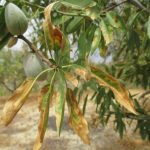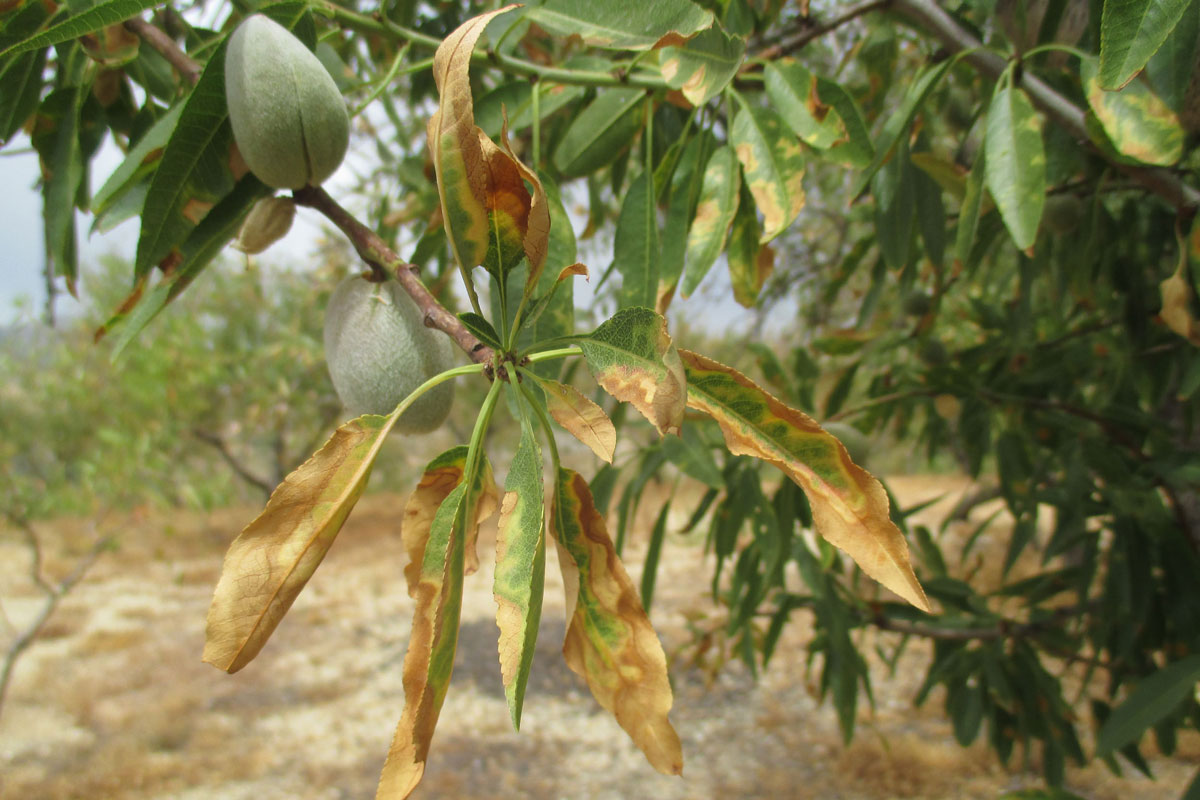 The Balearic population has to «coexist» with xylella fastidiosa, as «a bacterium that is already established in the natural environment is impossible to eliminate», Blanca Landa, a researcher at the Institute of Sustainable Agriculture of the Spanish National Research Council (IAS-CSIC), said at a press conference on Friday. «It is possible to coexist with the bacteria when the sector is reconverted, the plots will have to begin to establish new, more tolerant varieties and more technified agriculture», she explained. The researcher presented the conclusions of the study «Characterisation of the populations of the phytopathogenic bacteria in the Balearic Islands» and assured that in the case of the islands, as they are considered an infected area, the eradication procedure does not have to be carried out as it is being done on the mainland, in places such as Alicante. «Today we have more knowledge than we did two years ago, and that is what is important, to know the plant species that harbour the bacteria,» he stressed.
The Balearic population has to «coexist» with xylella fastidiosa, as «a bacterium that is already established in the natural environment is impossible to eliminate», Blanca Landa, a researcher at the Institute of Sustainable Agriculture of the Spanish National Research Council (IAS-CSIC), said at a press conference on Friday. «It is possible to coexist with the bacteria when the sector is reconverted, the plots will have to begin to establish new, more tolerant varieties and more technified agriculture», she explained. The researcher presented the conclusions of the study «Characterisation of the populations of the phytopathogenic bacteria in the Balearic Islands» and assured that in the case of the islands, as they are considered an infected area, the eradication procedure does not have to be carried out as it is being done on the mainland, in places such as Alicante. «Today we have more knowledge than we did two years ago, and that is what is important, to know the plant species that harbour the bacteria,» he stressed.
He clarified that the most likely origin of the fastidiosa subspecies and of the multiple is California, so one of the most plausible hypotheses is that it was introduced by plant material from this geographical area. However, in the case of the pauca subspecies, genetic analysis phylogeny studies indicate that its origin is «totally unknown» and that it has a genetic recombination with the other subspecies, such as the multiple and fastidiosa subspecies. «This is a striking fact because for the bacterium to have been able to acquire genetic material from these subspecies it has to be from a geographical location where it has coexisted with multiple, fastidiosa and pauca», he pointed out, adding that currently there is no other known case of these three subspecies existing in any other area of the world. «In the Balearic Islands, yes, but we have to bear in mind that they are different islands, so we don’t know where this particular strain could have originated,» he said.
The study is part of the research project «ITS2017-095 Design and implementation of control strategies against Xylella fastidiosa», presented this Friday. It has been funded by the Sustainable Tourism Tax (ITS) and is divided into six research areas, which have been developed by the University of the Balearic Islands (UIB), the IAS-CSIC, the Institute of Agri-Food Research and Technology (IRTA) and the area of Agriculture of the Ministry of Agriculture, Fisheries and Food. The results were presented by research batches. In the «Study of varietal resistance/tolerance/susceptibility of almond tree, vine and olive tree crops against xylella fastidiosa» (UIB), presented by Bàrbara Maria Quetglas, it was found that there are varieties of vine that are more resistant to the bacterium. To carry out the project, two types of crops have been evaluated: on the one hand, a collection of vine varieties and, on the other, commercial vines.
The study determined a higher percentage of affectation in the commercial varieties. The behaviour is uneven depending on the variety, even so, among the least affected in the study carried out, the black Mantonegro and white Chardonnay varieties stand out, and the most affected is Giró ros. As for the almond tree, a lower presence of the bacterium has been observed in the Vairo variety and the most affected are the Corona and Alzina. The researchers emphasise that the conditions of crop management have a direct influence on the degree of affectation of this species, and the water and fertilisation variables are particularly important. The study has analysed from 2019 to 2021 the main species on the islands, which are almond trees, vines and olive trees, said Quetglas, who specified that they have analysed a total of 100 varieties of almond trees and about 60 varieties of vines. Other vegetation has also been investigated in «Detection and effect of Xylella fastidiosa on the wild vegetation of the Balearic Islands» (UIB), presented by Dr Juan Rita, from the Department of Biology, who has located 18 wild species sensitive to the bacterium, 10 of which were not known to be so until now. Most of the susceptible species are shrubby bushes such as white steppe, lavender, aladierno, rosemary, savory, gorse or Ibiza cattail.
As far as tree plants are concerned, the wild olive tree and the ash tree stand out. Regarding endemic species, a worrying affectation of the Mahon chamomile, in Menorca, has been detected. For the moment, the bacterium has not been detected on holm oak. Finally, the incidence of the disease within forest communities has also been analysed. The researchers consider that Xylella fastidiosa hardly enters the dense vegetation of the wild olive tree and affects peripheral forest areas more than its interior. In the study «Knowledge of insect vectors of Xylella on the islands and the capacity of transmission between host plants», presented by Dr Jordi Sabaté of IRTA, he found that of the approximately 5,000 potentially transmitting insects captured and analysed on the four islands, 8 % corresponded to Neophilaenus campestrisy, and 92 % to Philaenus spumarius. On Formentera, none of the insects tested positive. Sabaté explained that if the aim is to control the population, the «nymph» phase of the insect is the easiest for farmers to see, since a test can be carried out and a treatment with eco-insecticides or by tilling and cleaning up the grass. «Once it is not seen, it is more complicated because it is very mobile, it hides in the trees and in the natural environment we cannot apply insecticides either», he remarked.
He also specified that the nymphs are produced more or less from February to April, depending on the temperature, although he pointed out that in Ibiza they start earlier. «This is the time when a farmer can see it very easily, without having technicians,» he added. He also pointed out that once the adult vector has moved on, it moves through the grasses when they are a little green, and in mid-May, depending on the temperature, is when it jumps to the crop or to the surrounding woods and vegetation and «it is already much more difficult to treat». The study «Development of a system for detecting the incidence of Xylella fastidiosa in almond tree cultivation using aerial images on the island of Mallorca», presented by Dr Juan Antonio Navas of the IAS-CSIC, concludes that the correspondence between the presence of visual symptoms and infection by Xylella fastidiosa reaches an overall accuracy of over 90 %. The agricultural sector was present at the presentation of the results of this project, which cost 1.3 million euros.
No que diz respeito às plantas arbóreas, destaca-se a oliveira brava e o freixo. As regards endemic species, a worrying affliction of the Mahon camomile in Menorca has been detected. For the moment, the bacterium has not been detected in the Azinheira. Finally, the incidence of the disease in forest communities has also been analysed. The researchers consider that Xylella fastidiosa hardly enters the dense vegetation of wild olive groves and affects more the peripheral forest areas than the interior. In the study «Knowledge of insect vectors of Xylella on the islands and the capacity for transmission between host plants», presented by Dr. Jordi Sabaté of IRTA, he discovered that of the nearly 5,000 potentially transmitting insects captured and analysed on the four islands, 8% corresponded to Neophilaenus campestrisy, and 92% to Philaenus spumarius. In Formentera, none of the insects tested positive. Sabaté explained that if the objective is to control the population, the «nymph» phase of the insect is the easiest for farmers to see, once a test and treatment can be carried out with eco-insecticides or by washing and cleaning the cowslip. «When it is not seen, it is more complicated because it is very mobile, it hides in the trees and in the natural environment we cannot apply insecticides», he observed.
He also specified that the nymphs are produced more or less from February to April, depending on the temperature, although he has noted that in Ibiza they begin more slowly. «This is the time when a farmer can see it very easily, without having technicians», he added. He also pointed out that once the adult vector has moved, it moves through the grasses when they are a little green, and in the middle of May, depending on the temperature, that is when it jumps to the crop or to the surrounding bush and vegetation and «it is much more difficult to treat it». O estudo «Desenvolvimento de um sistema de detecção da incidência da Xylella fastidiosa no cultivo de amendoeiras utilizando imagens aéreas na ilha de Maiorca», apresentado pelo Dr Juan Antonio Navas do IAS-CSIC, conclui que a correspondência entre a presença de sintomas visuais e a infecção pela Xylella fastidiosa atinge uma precisão global superior a 90 %. The agricultural sector was present at the presentation of the results of this project, which cost 1.3 million euros.
